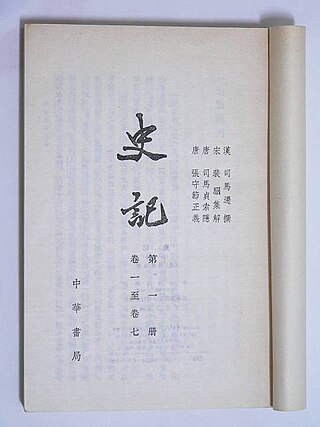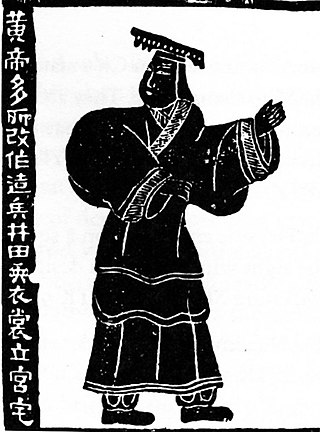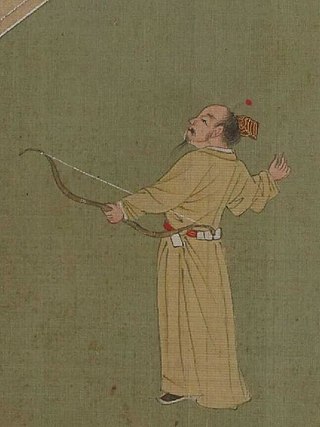
The Shang dynasty, also known as the Yin dynasty, was a Chinese royal dynasty that ruled in the Yellow River valley during the second millennium BC, traditionally succeeding the Xia dynasty and followed by the Western Zhou dynasty. The classic account of the Shang comes from texts such as the Book of Documents, Bamboo Annals and Records of the Grand Historian. Modern scholarship dates the dynasty between the 16th to 11th centuries BC, with more agreement surrounding the end date than beginning date.

The Xia dynasty is the first dynasty in traditional Chinese historiography. According to tradition, it was established by the legendary Yu the Great, after Shun, the last of the Five Emperors, gave the throne to him. In traditional historiography, the Xia was later succeeded by the Shang dynasty.

Records of the Grand Historian, also known by its Chinese name Shiji, is a monumental history of China that is the first of China's 24 dynastic histories. The Records was written in the late 2nd century BC to early 1st century BC by the ancient Chinese historian Sima Qian, whose father Sima Tan had begun it several decades earlier. The work covers a 2,500-year period from the age of the legendary Yellow Emperor to the reign of Emperor Wu of Han in the author's own time, and describes the world as it was known to the Chinese of the Western Han dynasty.
King Yuan of Zhou personal name Ji Ren, was the twenty-seventh king of the Chinese Zhou dynasty and the fifteenth of Eastern Zhou. He ruled from 476 BC to 469 BC. He was succeeded by his son, Prince Jie (王子介), who ruled as King Zhending of Zhou from 468 BC to 441 BC.
King Zhending of Zhou, personal name Ji Jie, was the twenty-eighth king of the Chinese Zhou dynasty and the sixteenth of Eastern Zhou. He ruled between 468 BC and 441 BC.
Sima is a Chinese family name. It is one of the rare two-character Chinese family names; most Chinese family names consist of only a single character. It is an occupational surname, literally meaning "control" (sī) "horses" (mǎ), or "horse officer". The family name originated from one of the offices of the Zhou dynasty.

The Yellow Emperor, also known as the Yellow Thearch or by his Chinese name Huangdi, is a mythical Chinese sovereign and cultural hero included among the legendary Three Sovereigns and Five Emperors, and an individual deity (shen) or part of the Five Regions Highest Deities in Chinese religion. Calculated by Jesuit missionaries, who based their work on various Chinese chronicles, and later accepted by the twentieth-century promoters of a universal calendar starting with the Yellow Emperor, Huangdi's traditional reign dates are 2697–2597 or 2698–2598 BC.

Yu the Great or Yu the Engineer was a legendary king in ancient China who was famed for "the first successful state efforts at flood control," his establishment of the Xia dynasty which inaugurated dynastic rule in China, and his upright moral character. He figures prominently in the Chinese legend titled "Great Yu Controls the Waters". Yu and other "sage-kings" of ancient China were lauded for their virtues and morals by Confucius and other Chinese teachers. He is one of the few Chinese monarchs who is posthumously honored with the epithet "the Great".
The Gonghe Regency was an interregnum period in Chinese history from 841 BC to 828 BC, after King Li of Zhou was exiled by his nobles during the Compatriots Rebellion, when the Chinese people rioted against their old corrupt king. It lasted until the ascension of King Li's son, King Xuan of Zhou.

The Battle of Muye, Mu, or Muh was a battle fought in ancient China between the rebel Zhou state and the reigning Shang dynasty. The Zhou army, led by Wu of Zhou, defeated the defending army of king Di Xin of Shang at Muye and captured the Shang capital Yin, ending the Shang dynasty. The Zhou victory led to the establishment of the Zhou dynasty, and is used in Chinese historiography as a justified example of the doctrine of the Mandate of Heaven.
Youyu-shi, also called Youyu clan or the Yu dynasty, is a proposed dynasty of China that could have existed prior to the Xia dynasty. The territory controlled by the Yu dynasty is hypothesized to have been located southwest of Pinglu County, in Shanxi Province, China. Its last monarch is believed to be Emperor Shun.
The Bamboo Annals, also known as the Ji Tomb Annals, is a chronicle of ancient China. It begins in the earliest legendary time and extends to 299 BC, with the later centuries focusing on the history of the State of Wei in the Warring States period. It thus covers a similar period to Sima Qian's Records of the Grand Historian. The original may have been lost during the Song dynasty, and the text is known today in two versions, a "current text" of disputed authenticity and an incomplete "ancient text".
The Xia–Shang–Zhou Chronology Project was a multi-disciplinary project commissioned by the People's Republic of China in 1996 to determine with accuracy the location and time frame of the Xia, Shang, and Zhou dynasties.

Qi was a Chinese king, the son of Yu the Great and the second sovereign of the Xia dynasty. He ruled for roughly nine to ten years.
Wen Wu Ding or Wen Ding (文丁) or Tai Ding (太丁), personal name Zi Tuo, was a king of the Shang dynasty of Ancient China. His reign was from 1116 to 1106 BC according to the Cambridge History, or 1112 to 1102/1 BC according to the Xia–Shang–Zhou Chronology Project.

Wu Yi (武乙), personal name Zi Qu (子瞿) was king of the Shang dynasty of ancient China from 1147 to 1112 BC. According to the Bamboo Annals, his capital was at Yin. He was a son of his predecessor Geng Ding and father of King Wen Ding.
The Emperor Zhi was a legendary emperor of ancient China.
Yuxiong, also known as Yuzi or Master Yu, was an early ruler of the ancient Chinese state that was later known as Chu. He was an ally and teacher of King Wen of Zhou, the first king of the Zhou dynasty. In the Tsinghua Bamboo Slips his name is written as Xuexiong.
The Predynastic Zhou or Proto-Zhou refers to the state of Zhou that existed in the Guanzhong region of modern Shaanxi province during the Shang dynasty of ancient China, before its conquest of the Shang in 1046/1045 BC which led to the establishment of the Zhou dynasty. It was ruled by the Ji clan. According to histories, Predynastic Zhou rose as a western vassal of the Shang, acting as its ally until their influence surpassed that of the dynasty.
The following outline is provided as an overview of and topical guide to ancient China:







